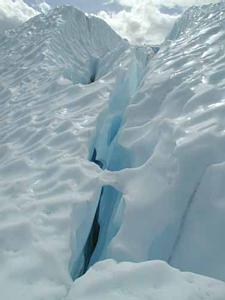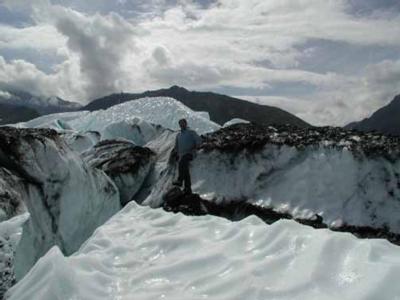14 July, 2000
July 14, 2000
Matanuska Glacier, Alaska
This morning Ben and I measured the conductivity of the samples that
were left to settle over night. It seems that this does provide a better
method than shaking the bottles just before testing. There doesn’t seem
to be nearly as much variation in the data and the graphs look much
smoother as a result. Perhaps the suspended sediment interferes somehow
with the instrument.
What we consistently seem to see in our data is a decrease in
conductivity during the time we sample. This is expected to some extent
because the melting on the glacier increases during the day and into the
early evening. This added pure water slowly dilutes the subglacial
drainage and drives the conductivity of the silty discharge from the
vents down. We’ve been hoping to see a rise during this period which we
could attribute to the salt. In spite of getting better readings by this
method, we are still coming up empty handed. We think that either: (1)
the salt is not dissolving in the conduits fast enough (2) there is too
much dilution before it reaches the ISCOs (3) the moulin drains to
different vents or (4) a combination of factors. We think we may proceed
with the rhodamine dye experiments very soon.
After collecting more ISCO samples from the two vent stations we had
some free time and decided to explore certain parts of the glacier. In
parcticular Ben wanted to follow some cracks in the area of our moulin to
see where they went and if something else was going on along their
length. We both wanted to go higher up on the glacier than we normally
do during our work just to explore the scenery and have a little fun.
With crampons on we made our way up the glacier and onto the white ice.
In many places we saw all different shades of blue coming out of the
ice. This occurs because the other colors of sunlight are being
absorbed, but the blue is not. We’ve also seen black ice but that is due
to no light coming out of the ice at all. The ice is black under the
rock debris that’s scattered around the north part of the terminus. The
rocks, sand and silt block the light from entering the ice at all. As a
result, little or no light can reflect or scatter back to the surface.
Mounds of black ice can be very difficult to cross. You can’t really see
that there is even ice under there. It just looks like a pile of sand
and rock much of the time. If you’re walking on it without crampons
you’re sure to lose your footing and take a hard fall.
But where we were headed it was all nice clean white ice. Wherever there
were cracks or narrow crevasses we would see many beautiful shades of
blue. As we moved higher up the ice the surface texture changed
noticeably and it got much warmer for some reason. Lower on the ice the
surface seemed really granular and normal hiking shoes could almost
suffice. But up high it took a very smooth,wavy, almost fish-scale type
of appearance. You had to kick hard with the crampons to get secure
footing. We were very careful to pick a route that would be forgiving
should we slip. Something odd we both noticed was that the dimpled
surface of ice seemed to have pink rings where the “ridges” of the
dimples were. It sort of caused you to lose your depth perception to
some extent. I think it was our eyes playing tricks on the bright
reflective ice. We agreed that polarized glasses would have been
helpful.
At one point we came to an impressive crevasse which groaned quite often
and very mysteriously. The walls were probably serving to amplify the
cracking sounds that travel through the ice. As I peered into its deep
blue I wondered how far away some of these sounds could have originated.
I managed to roll a rather large boulder off its perch and into the
chasm below. It gave a deep thud with each bounce off the walls and
finally a huge splash at the end. Judging from the sound and time I
estimate it was about 100 feet down to the water (which we could not
see). This thing was huge and we were very careful about our positions
here. We continued up the glacier a bit more but were forced to turn
back. The ice was no longer gently rolling but had become quite
impassable. We had managed to go quite a distance up the glacier.
On our return down the glacier I stopped many times for a drink of the
meltwater from the many rivulets. It was so delicious and of course ice
cold. We also paid another visit to the glacial lake that Ben Cashman
had shown us last week. As we hiked its northern icy shoreline I was
looking for other routes to explore on the far side of the lake. I’m
certain that we will get several more chances for these hikes. It was a
good thing to get away from the work for just a short while. Tomorrow we
will pick up the work once again. Till then.....
Marvin Giesting

You can see various shades of blue in this small crevasse. Also notice the smooth wavy appearance of the ice. We had to be extra careful of our crampon holds on this type of ice.

The boulder under my left foot was sacrificed to the deep crevasse below.

Beautiful reflection of seracs on the glacial lake. It was very peaceful here listening to numerous small streams dump into this lake from all around!
Contact the TEA in the field at
.
If you cannot connect through your browser, copy the
TEA's e-mail address in the "To:" line of
your favorite e-mail package.
|
